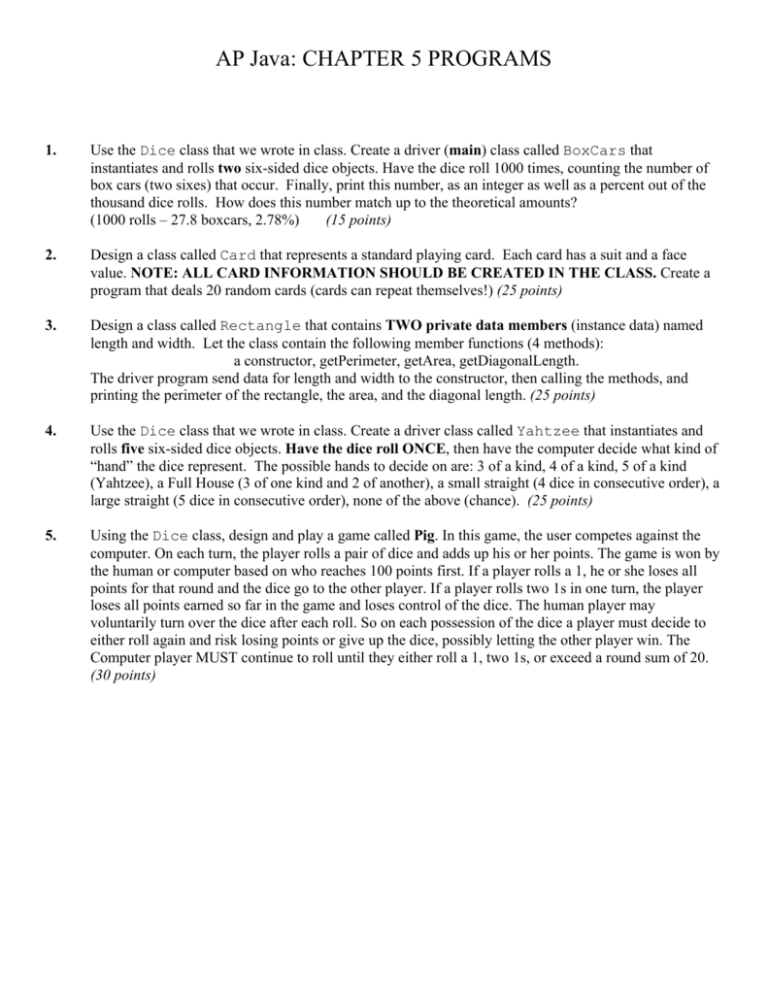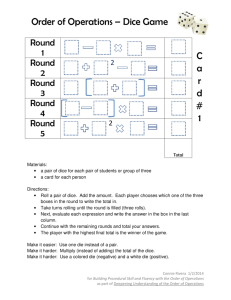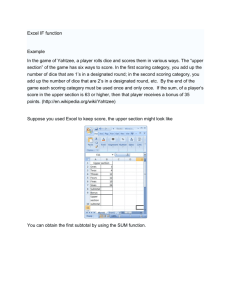AP Java: CHAPTER 5 PROGRAMS
advertisement

AP Java: CHAPTER 5 PROGRAMS 1. Use the Dice class that we wrote in class. Create a driver (main) class called BoxCars that instantiates and rolls two six-sided dice objects. Have the dice roll 1000 times, counting the number of box cars (two sixes) that occur. Finally, print this number, as an integer as well as a percent out of the thousand dice rolls. How does this number match up to the theoretical amounts? (1000 rolls – 27.8 boxcars, 2.78%) (15 points) 2. Design a class called Card that represents a standard playing card. Each card has a suit and a face value. NOTE: ALL CARD INFORMATION SHOULD BE CREATED IN THE CLASS. Create a program that deals 20 random cards (cards can repeat themselves!) (25 points) 3. Design a class called Rectangle that contains TWO private data members (instance data) named length and width. Let the class contain the following member functions (4 methods): a constructor, getPerimeter, getArea, getDiagonalLength. The driver program send data for length and width to the constructor, then calling the methods, and printing the perimeter of the rectangle, the area, and the diagonal length. (25 points) 4. Use the Dice class that we wrote in class. Create a driver class called Yahtzee that instantiates and rolls five six-sided dice objects. Have the dice roll ONCE, then have the computer decide what kind of “hand” the dice represent. The possible hands to decide on are: 3 of a kind, 4 of a kind, 5 of a kind (Yahtzee), a Full House (3 of one kind and 2 of another), a small straight (4 dice in consecutive order), a large straight (5 dice in consecutive order), none of the above (chance). (25 points) 5. Using the Dice class, design and play a game called Pig. In this game, the user competes against the computer. On each turn, the player rolls a pair of dice and adds up his or her points. The game is won by the human or computer based on who reaches 100 points first. If a player rolls a 1, he or she loses all points for that round and the dice go to the other player. If a player rolls two 1s in one turn, the player loses all points earned so far in the game and loses control of the dice. The human player may voluntarily turn over the dice after each roll. So on each possession of the dice a player must decide to either roll again and risk losing points or give up the dice, possibly letting the other player win. The Computer player MUST continue to roll until they either roll a 1, two 1s, or exceed a round sum of 20. (30 points)




